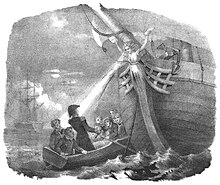
The Water-Witch is an 1830 novel by James Fenimore Cooper. Set in 17th-century New York and the surrounding sea, the novel depicts the abduction of a woman, Alida de Barbérie, by the pirate captain of the brigantine Water-Witch, and the subsequent pursuit of that elusive ship by her suitor, Captain Ludlow.
Cooper wrote the novel while on an extended tour of Europe, during his stay in the villa Palazzu detta del Tasso near Naples. Cooper tried to print the novel while he was in Italy in 1829 but Papal censors forbade its publication there. He was eventually able to print the novel in Dresden before also sending copies to his publishers in the US and England. Critic Allan Axelrad describes the novel as heavily influenced by the Italian context of its writing, noting that it even compares the landscapes of New York with that of Italy.
The unincorporated community of Waterwitch, New Jersey is named after the novel.
References
- ^ Baym, Max I.; Matenko, Percy (January 1970). "The Odyssey of The Water-Witch and a Susan Fenimore Cooper Letter". New York History. LI (1): 33–41 – via James Fenimore Cooper Society.

- "The Great Snow Storm: Extract for a Letter from William E. Waples, Esq". The Register of Pennsylvania. Vol. 7, no. 16. April 16, 1831. p. 246. ProQuest 91284032.
- Axelrad, Allan M. (July 1993). James D. Wallace (ed.). Epiphany at Ischia: The Effect of Italy on James Fenimore Cooper's Literary Landscape Painting. 9th Cooper Seminar, James Fenimore Cooper: His Country and His Art. State University of New York College at Oneonta. pp. 1–27.
- Paul T. Hellmann (14 February 2006). Historical Gazetteer of the United States. Routledge. p. 722. ISBN 1-135-94859-3.
Further reading
- Lampe, David (July 2013). Steven Harthorn (ed.). Double Dutch Delights: Irving's Knickerbocker History and Cooper's Water Witch. 19th Cooper Seminar, James Fenimore Cooper: His Country and His Art. State University of New York College at Oneonta. pp. 18–24.
External links
- The Water-Witch at Project Gutenberg
- Scans and transcription of the Original Dresden printing of the novel
This article about an 1830s novel is a stub. You can help Misplaced Pages by expanding it. See guidelines for writing about novels. Further suggestions might be found on the article's talk page. |